Cockleshell Heroes based in Portsmouth
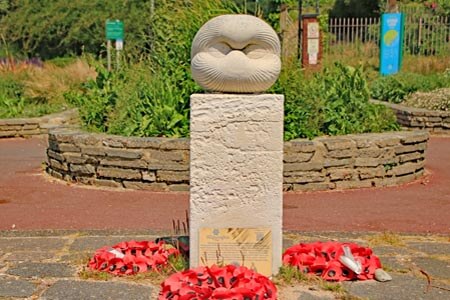
Explore the heroic mission carried out in 1942 by British Commandos on the German occupied French port of Bordeaux in southwest France during the Second World War. Ten members of the Royal Marine Boom Patrol Detachment (RMBPD) set out to attack the cargo vessels docked there, but only two of the volunteers returned home.
Two marines drowned when their canoe sank, four were captured by the Germans after capsizing and another two marines were captured after the attack. All six captured marines were executed by the German forces.
Although officially known as Operation Frankton the daring raid is better known by the name The Cockleshell Heroes after the fictional 1955 film of the same name which portrays the operation. Several scenes in the film were shot at Portsmouth including the former Royal Marines Barracks at Eastney, Portsmouth Dockyard, Fort Brockhurst railway station at Gosport also features.
Operation Frankton
The port of Bordeaux in France was a major hub in the German war effort, goods such as vegetable and animal oils, other raw materials, and thousands of tons of crude rubber passing through the port.
Operation Frankton formulated by Major Herbert 'Blondie' Hasler was for six two seater canoes, known as cockles, to be transported by submarine to the Gironde estuary. from there the two man crews would paddle up the Gironde at night to the port of Bordeaux. Once at Bordeaux the commandos would attach limpet mines to the moored shipping to sink or badly damage the vessels and their precious cargoes.
The men selected for the operation were divided into two divisions and assigned particular target vessels to attack.
- A Division
- Hasler and Marine Bill Sparks in kayak Catfish.
- Corporal Albert Laver and Marine William Mills in kayak Crayfish.
- Corporal George Sheard and Marine David Moffatt in kayak Conger.
- B Division
- Lieutenant John Mackinnon and Marine James Conway in kayak Cuttlefish.
- Sergeant Samual Wallace and Marine Robert Ewart in kayak Coalfish.
- Marine W. A. Ellery and Marine E. Fisher in kayak Cachalot.
A thirteenth man was taken as a reserve, Marine Norman Colley.
The men and their cockles were transported to the Gironde estuary by Royal Navy submarine HMS Tuna arriving on 7th December 1942, slightly delayed by bad weather and having had to negotiate a minefield.
Ellery and Fisher's canoe was damaged whilst leaving the submarine and therefore could not be launched, the five remaining teams continued with the mission. Sheard and Moffatt's canoe capsized and was scuttled by the crew who eventually swam ashore, they later died of hypothermia.
The pair MacKinnon and Conway got into trouble and had to leave their canoe, once ashore they evaded capture for four days but were arrested by the French Police and handed over to the German authorities.
Wallace and Ewart were captured near the Pointe de Grave lighthouse.
The two remaining crews reached Bordeaux on the fifth night of the operation and were able to attach their mines destroying or damaging six of the cargo vessels moored in the dock.
After the attack the plan was for the crews to make their way south and escape across the Spanish border. Laver and Mills were captured at Montlieu-la-Garde after two days.
Hasler and Sparks did manage to escape across the Pyrenees into Spain aided by members of the French Resistance.
MacKinnon, Conway, Wallace, Ewart, Laver and Mills were all executed by the German's for their part in the Commando raid.
Cockleshell Heroes Portsmouth
The Royal marines have a long association with Portsmouth, they moved into Eastney Barracks, Southsea in 1867 having previously been based at Fort Cumberland. In the film version of The Cockleshell Heroes many views of Eastney Barracks can be seen especially the main gate area on Cromwell Road.
Although depicted in the film dramatisation as training at Eastney Barracks the Royal Marine Boom Patrol Detachment (RMBPD) group, a forerunner of the Special Boat Service (SBS), for Operation Frankton actually trained at Lumps Fort, now known as the Rose Gardens on Southsea Seafront. There is a plaque at the northern entrance to the Rose Gardens that reads.
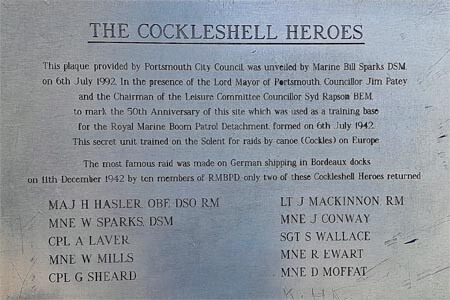
"THE COCKLESHELL HEROES
This plaque, provided by Portsmouth City Council, was unveiled by Marine Bill Sparks DSM on 6th July 1992, in the presence of the Lord Mayor of Portsmouth, Councillor Jim Patey and the Chairman of the Leisure Committee Councillor Syd Rapson BEM, to mark the 50th Anniversary of this site which was used as a training base for the Royal Marine Boom Patrol Detachment, formed on 6th July 1942. This secret unit trained on the Solent for raids by canoe (Cockles) on Europe.
The most famous raid was made on German shipping in Bordeaux docks on 11th December 1942 by ten members of RMBPD, only two of these Cockleshell Heroes returned:"
The unit trained in The Solent around the boom that protected the channel between the Isle of Wight and Portsmouth, similar to the defences they would encounter on the Gironde estuary. They also trained at night paddling undetected around Portsmouth Naval Base to simulate attaching their limpet mines to shipping.
Worthing Road, Southsea
Whilst in training the unit lived at a guest house called White Heather in Worthing Road in Southsea, there is now a plaque on the front of the house. The plaque erected on the 70th anniversary of the raid by Portsmouth City Council has the following text:
"THE COCKLESHELL HEROES
The men who launched the commando raid on Bordeaux harbour in 1942 lived in this house whilst training at the Lumps Fort at Southsea.
Only two survived to make it home, of the others, two were drowned, six were captured and executed."
Cockleshell Gardens, Eastney
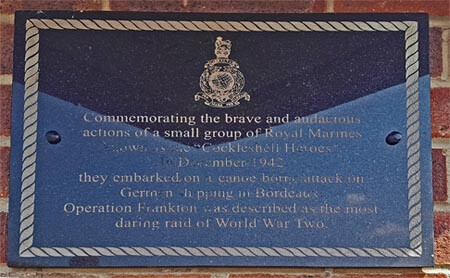
In honour of the Cockleshell Heroes there is now a road named Cockleshell Gardens in Eastney, close to the former Royal Marine Barracks Eastney, the corner house has a small plaque displaying details of the operation.
The plaque reads as follows:
"Commemorating the brave and audacious actions of a small group of Royal Marines known as the Cockleshell Heroes, in December 1942 they embarked on a canoe borne attack on German shipping in Bordeaux.
Operation Frankton was described as the most daring raid of World War Two."
The commemorative stone below is in the memorial garden at the former Royal Marines Barracks Eastney and the blue plaque can be found at the house in Worthing Road, Southsea where the Cockleshell Heroes lived whilst training at Lumps Fort, Southsea.
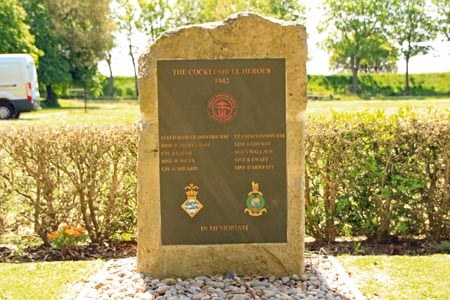
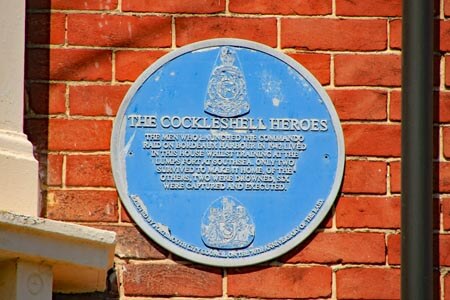
Fred Goatley - "Cockle" designer
The folding canoe used during Operation Frankton were designed by Fred Goatley and were constructed at the Saunders-Roe Ltd (SARO) Folly works at Whippingham, Isle of Wight, on the banks of the River Medina. Originally the Folly Works built seaplanes and boats. Fred Goatley was the manager of the Folly Plywood factory which later became SARO. He retired in 1938 but continued designing boats in his workshed. He designed the "Cockle" and returned to work to oversee their construction for use in Operation Frankton. Fred Goatley's contribution to victory in World War II was immense. As well as the Cockleshells he designed many other types of military vessels such as the 'Goatley' a canoe with a detachable motor, used in 1944 during Operation Market Garden in the Netherlands.